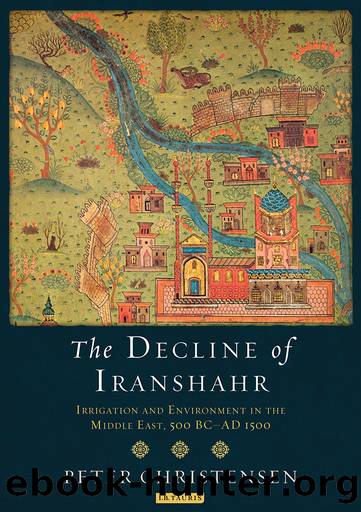The Decline of Iranshahr by Peter Christensen;

Author:Peter Christensen;
Language: eng
Format: epub
Publisher: Bloomsbury UK
Published: 2016-01-15T00:00:00+00:00
Chapter 14
Kirman
As indicated by the tax assessments, Kirman occupied a somewhat peripheral position within Iranshahr. It was an arid land of dispersed settlements, far from the imperial centers, a refuge for rebels and dissidents. Its resources were modest, and for long periods the local rulers were left reasonably undisturbed.1
In physical terms the land consisted, roughly speaking, of two parts. âWarm Kirman,â Garmkirman, i.e. the region south of the central Kuh-é Lalehzar massif, was watered by several streams, but as these were mostly seasonal, many settlements were supplied with extra water from qanats or cisterns. âCold Kirmanâ (the sardsir), north of the central massif, was a region of desolate basins and valleys facing the great desert Dasht-é Lut. Settlement in pre-historical and early historical times was here limited to a few small, natural oases.
In Sassanian and early Muslim times both parts of Kirman saw considerable settlement expansion. Later, however, there was a divergence: the south, which apparently offered the best conditions for settlement, declined, while settlement in the north, inspite of the inhospitable environment, the frequent natural disasters and wars, proved resilient.
1. The Colonization of North Kirman
The north of Kirman was one of those arid areas on the edge of the great Iranian deserts which the qanat-technology opened up for colonization. Expansion of settlement began in earnest in the 3rd century when Ardashir I, immediately after his conquest of Kirman, founded a new town, Veh-Ardashir, on the edge of the Dasht-é Lut. The name was eventually transformed into Bardasir or Guwashir.2 Ardashirâs intention was no doubt to establish a military base, but in this barren, isolated country even a small garrison could subsist only in an oasis, so this had literally to be constructed together with the town. In the 10th century Veh-Ardashir, which had then just become the capital of all Kirman, is described a small heavily fortified town surrounded by gardens and watered by many qanats, wells, and cisterns. We have no earlier descriptions, but the Sassanian town must have looked much the same.3
Local traditions has it that a Sassanian governor founded the town of Mahan at the foot of Mount Djupar, southeast of Veh-Ardashir.4 Further colonization of âCold Kirmanâ took place in the 4th century when Shapur II settled prisoners of war from his Arabian campaign in âAban.â Le Strange identifies this place with present-day Anar, a small qanat-watered oasis on the edge of the desert between Yazd and Rafsandjan.5
Download
This site does not store any files on its server. We only index and link to content provided by other sites. Please contact the content providers to delete copyright contents if any and email us, we'll remove relevant links or contents immediately.
| Africa | Americas |
| Arctic & Antarctica | Asia |
| Australia & Oceania | Europe |
| Middle East | Russia |
| United States | World |
| Ancient Civilizations | Military |
| Historical Study & Educational Resources |
Empire of the Sikhs by Patwant Singh(22759)
The Wind in My Hair by Masih Alinejad(4836)
The Templars by Dan Jones(4556)
Rise and Kill First by Ronen Bergman(4542)
The Rape of Nanking by Iris Chang(4020)
12 Strong by Doug Stanton(3418)
Blood and Sand by Alex Von Tunzelmann(3055)
The History of Jihad: From Muhammad to ISIS by Spencer Robert(2504)
Babylon's Ark by Lawrence Anthony(2427)
The Turkish Psychedelic Explosion by Daniel Spicer(2245)
No Room for Small Dreams by Shimon Peres(2235)
Gideon's Spies: The Secret History of the Mossad by Gordon Thomas(2230)
Inside the Middle East by Avi Melamed(2230)
Arabs by Eugene Rogan(2193)
The First Muslim The Story of Muhammad by Lesley Hazleton(2153)
Bus on Jaffa Road by Mike Kelly(2034)
Come, Tell Me How You Live by Mallowan Agatha Christie(2022)
Kabul 1841-42: Battle Story by Edmund Yorke(1921)
1453 by Roger Crowley(1879)
